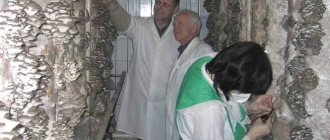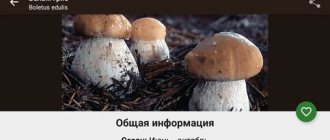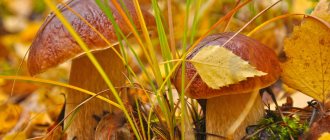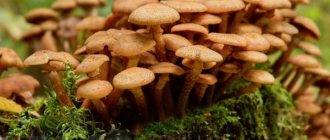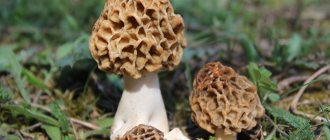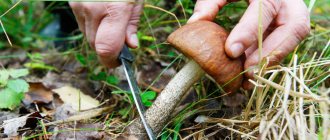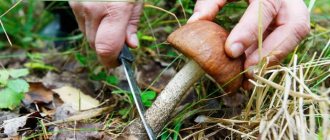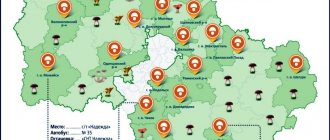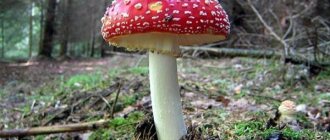Which mushrooms can be eaten and which cannot?
Almost all of them belong to the lamellar group, that is, they have plates on the underside of the cap.
- Pale grebe (Amanita phalloides) ...
- White or spring fly agaric (Amanita verna) ...
- Panther or gray fly agaric (Amanita pantherina) ...
- Red fly agaric (Amanita muscaria) ...
- Poisonous row (Tricholoma pardinum)
Oct 9
2022 Interesting materials:
What is a work? What is the means of user authentication? What is the raw material for the production of sulfuric acid? What goes with Burgundy? What comes after a magnificent century? What's included with iPhone 11? What did Elon Musk launch into space? What was used to irrigate fields in Ancient Egypt? What is used instead of roofing felt? What is a correspondence course?
Description of mushrooms growing on a birch tree
Some fungi are parasitic and grow directly on tree trunks or branches. Often in the forest you can find birch trees, from the trunks of which gray caps of oyster mushrooms or large lumpy growths of tinder fungus can be seen.
Chaga or birch mushroom
Chaga or tinder fungus is a basidiomycete that “settles” on damaged and dying trees. Sometimes it is found on alders, rowan trees, beech trees, elms, ash trees and maples. But most often the fungus infects birch trees.
This parasite is found in deciduous and mixed forests of the temperate zone of the Northern Hemisphere. It reproduces by spores that penetrate into the cracks of diseased trees. There they develop and turn into a large, lumpy, dark gray growth.
Typically, the sporocarp grows 3-4 years after the wood is infected. The resulting growth has an irregular shape with a cracked surface. The interior of the mushroom is permeated with colorless hyphae resembling white veins. Color varies from dark brown to reddish-brown.
Oyster mushrooms
Quite tasty and popular mushrooms, oyster mushrooms, often grow on birch trees. They have a large fleshy cap, the diameter of which can reach 15 cm. Its structure is solid, round with a thin edge. Sometimes ear-shaped and shell-like fruits are found.
Young specimens have a convex shape with a rolled edge; over time, it opens up and becomes flat. The surface of the oyster mushroom is smooth, shiny, sometimes covered with plaque. In color it can be gray, brown or yellow, sometimes even white. Oyster mushrooms have a pleasant taste with a faint anise aroma.
Honey mushrooms
Another parasitic species of fungi is the honey fungus, which attacks various deciduous trees. Most often, these fungi are found on dead or weakened birch trees. Small sporocarps usually have a plump stem and a small cap with a diameter of no more than 10 cm.
Honey mushrooms grow in large families, making them easy to distinguish from false representatives. Another distinctive feature is the round caps with a tubercle in the middle. In young specimens they are completely covered with characteristic scales, which disappear with age.
Old overripe mushrooms
You cannot collect and eat old overripe specimens, even if they have not been touched by worms. Such mushrooms are large in size, have loose pulp and contain breakdown products of proteins and other substances.
Toxins found in old mushrooms can disrupt the respiratory and nervous systems and disrupt the heart rate.
There is even a saying: “The mushroom has outgrown - the man has found danger on his nose.”
Mushrooms growing in contaminated areas can also lead to poisoning, as they have the ability to absorb nitrates, pesticides and other harmful substances from the environment. It is prohibited to collect mushrooms near roads, near landfills and under power lines.
Usable types
There are more than a thousand species of edible mushrooms, most of which belong to macromycetes. But some varieties are hybrids of fungi and plants. This category includes those that do not pose a danger to human health and life and are of particular value in cooking. They have a pleasant taste, and the prepared dishes do not become boring.
Good species are distinguished by a lamellar or spongy structure on the underside of the cap. Edible mushrooms also have other characteristics:
- frequency of arrangement of plates on the cap;
- spore color;
- method of attaching the plates to the leg;
- the color of the pulp before and after pressing on it.
The mycelium from which mushrooms emerge resembles light mold. She appears on a rotting tree. Its fibers entwine the roots of the tree, saturating it with organic matter and receiving in return moisture and mineral elements for nutrition. Some names come precisely from the type of tree to which they are attached.
The following types of mushrooms can most often be found in forests:
- common oakwood;
- pine mushroom;
- boletus;
- registry;
- boletus
Mushroom pickers in mixed and coniferous forests collect the following varieties:
- saffron milk caps;
- honey mushrooms;
- chanterelles;
- Champignon;
- boletus;
- Russula;
- milk mushrooms
After collecting mushrooms, it is best to put them in a wicker basket, which allows you to check them and maintain their original shape. It is better not to use the bag, as when you come home you may find a shapeless mass in it. It is necessary to collect only those mushrooms that are probably known to the mushroom picker. Wormy legs and old caps should alert a forest hunter. Morning is the best time for picking in the autumn forest, as the mushrooms are still strong and fresh.
Answers to common questions
When does the mushroom season begin in our forests? The mushroom season begins in July and lasts until October. The peak yield is observed in August.
What poisonous mushrooms appear first? As a rule, toadstools appear first. They can be seen already in early spring - in early or mid-April.
Can an edible mushroom be dangerous to humans? Mushrooms, traditionally considered edible, can be hazardous to health if they grow in areas with unfavorable environmental conditions. Mushrooms absorb toxic and harmful substances and accumulate them in themselves.
Due to the wide variety of mushrooms, it is important to learn how to identify their type, and collect only those that are not in doubt. Having studied the descriptions of various species and the rules of “quiet hunting”, you can safely collect a rich harvest and prepare many dishes from it
Do mushrooms grow after frost? Do saffron milk mushrooms grow after frost?
For many inexperienced mushroom pickers, the question arises: is it possible to collect saffron milk caps after the first frost? The ground does not have time to freeze after the first frost, and the mushrooms are hidden under fallen leaves. Therefore, there is nothing wrong with collecting saffron milk caps in late autumn, because they also do not have time to freeze. Usually frosts are observed only at night, while during the day the temperature can reach +10°C. You can safely go on a “silent hunt” for tasty and healthy saffron milk caps.
Is it possible to collect saffron milk caps after frost if it lasted for several days? Typically, these fruiting bodies are harvested before the first frost, while the weather remains warm, or after 2-3 days. However, if the cold weather lasted more than 3-5 days and the air temperature remained below +6°C, then it is not recommended to collect saffron milk caps, since they completely lose their taste.
Typically, saffron milk caps grow from mid or late summer (depending on the area and climatic conditions) until the first half of October. However, it also happens that you can search for saffron milk caps throughout November if the weather remains favorable. Do saffron milk caps grow on the soil after frosts? Note that saffron milk caps do not stop growing with the arrival of the first frost, as they are under a thick layer of foliage and moss. However, as mentioned above, the fruiting bodies lose their taste. Is it possible to eat saffron milk caps after frost if they have no taste? Experts say that after freezing, mushrooms not only lose their taste and aroma. It turns out that substances that can cause food poisoning sometimes accumulate in thawed fruiting bodies.
According to many mushroom pickers, saffron milk caps are considered noble fruiting bodies. Although they belong to the Milky family, they still do not have bitterness. In addition, they can be eaten even raw, simply sprinkled with salt. However, collecting and using saffron milk caps after frost is still not recommended for the reasons described at the beginning. Only the bravest can collect saffron milk caps after frost and prepare delicious dishes from them, especially if they are fried with the addition of sour cream and garlic, which give the mushrooms a piquant taste.
False honey mushrooms
All representatives of false mushrooms belong to one common genus “Hyfoloma”, which indicates their close relationship, and, accordingly, similarity in appearance.
1. Seroplate honey fungus
(Hypholoma capnoides) - edible. An absolutely edible mushroom of good quality, despite the fact that it is classified as a false mushroom. The main feature of the honey fungus is the fact that it grows exclusively on stumps and decaying wood of coniferous trees. In the vast majority of cases on pine, less often on spruce. The danger for inexperienced mushroom pickers lies in its great similarity to the poisonous sulfur-yellow honey fungus, which is described below. Therefore, remember that you should not take a mushroom from the forest that you are not sure about! In cooking it is used similarly to summer honey fungus.
2. Brick-red honey fungus
(Hypholoma lateritium) - conditionally edible. A rather controversial mushroom, since different sources provide different information about its edibility. Some authors label brick-red honey fungus as mildly poisonous, but in most books it is described as edible. Grows on stumps and rotting deciduous trees throughout the summer and fall. It is similar to the poisonous sulfur-yellow honey fungus. On the forums you can meet people who collect brick-red honey fungus, but personally I have never taken it, and why, when there are other edible and tasty mushrooms?
3. Sulphur-yellow honey fungus
(Hypholoma fasciculare) - poisonous. A poisonous representative of false mushrooms. The mushroom is found in the forest from late May until late autumn. It prefers to grow on rotten trees, stumps, and sometimes on the ground if it contains remains of decaying wood. Sometimes it bears fruit in large numbers. Sulphur-yellow false honey fungus is very similar to the edible sulphur-yellow false honey fungus. It is worth highlighting two main differences between these mushrooms: 1. sulfur-yellow honey fungus has plates of a greenish tint (in the sulphurous honey fungus they are gray), 2. sulfur-yellow honey fungus grows exclusively on coniferous trees (pine, less often spruce), sulfur-yellow on any. When eaten, sulfur-yellow honey fungus causes stomach upset, nausea, and vomiting.
Edible species that grow under birch trees
Sometimes it is only by the place of growth that you can distinguish an edible mushroom from its poisonous counterpart. The most common species found in birch groves are boletus, russula, trumpets, and milk mushrooms.
boletus
When asked what mushrooms grow in birch groves, boletus immediately comes to mind. Indeed, the name of the species speaks for itself. These edible mushrooms grow exclusively near the roots of birch trees.
In nature, there are about 40 varieties of boletus, however, in appearance they are all similar to each other. The fruit body consists of a white or dark brown cap and a gray cylindrical stalk. The surface of the mushroom is smooth, but in wet weather it is sticky and slimy. The pulp is light, dense, and darkens slightly in places of damage.
Real milk mushroom
Often in birch and spruce-birch forests you can find a not very popular, but very useful mushroom - the real milk mushroom. It has a wide mucous cap with a depression in the middle. Ripe fruiting bodies are harvested from July to September. They usually grow in small groups and hide under a layer of forest litter.
The flesh of milk mushrooms is developed, dense and brittle, usually white. In air it does not change color, but its milky juice becomes yellowish. Has a slight mushroom smell.
Porcini
It is believed that boletus has the greatest nutritional value among all the mushrooms available in Russia. Some of its subspecies appear only under birch trees, forming mycorrhiza with it. From June to September, entire groups of valuable fruiting bodies can be found in the forests.
The boletus cap is quite large: up to 15 cm in diameter. It has a light brown or yellow color. It is shaped like a pillow, which becomes flatter over time.
Porcini mushroom has excellent taste, which is highly valued in all European countries. Its dense, white flesh has a pleasant mushroom aroma that can add flavor to any hot dish. However, boletus is very easy to confuse with the inedible gall mushroom, so you should be especially careful when collecting.
Russula scaly
Russula scaly or greenish grows in all deciduous forests and often enters into symbiosis with birch trees. It has a noticeable cap, the diameter of which can reach 15 cm. It is usually green or gray-green in color with torn skin at the edges.
Below are rare plates with white spore powder. The leg is white, dense and fleshy, and has a spicy nutty taste. This subspecies is superior in taste to all other russulas, for which it is very popular among the people.
Important! Scaly russula is very easy to confuse with toadstool, so you should be extremely careful when collecting.
Volnushka white
Also on a “quiet hunt” you can find an unusual and very attractive white wave in a birch grove. It has a pale, almost white color and a small fluff on the surface, which distinguishes it from other mushrooms. The cap is small, flat-convex with upward-curved edges. It is almost smooth in the center, sometimes sticky and slimy.
Despite the fact that whitefish grows in families, it is quite rare. Perhaps it is for this reason that many mushroom pickers avoid it. Before cooking, the volushka should be soaked in water for a very long time, as it has an unpleasant bitter taste.
The nutritional value
Mushrooms contain a large amount of protein, are rich in minerals, the energy value of porcini mushrooms is over 938 kJ, they contain vitamins and organic acids. In short, mushrooms are a storehouse of nutrients. But it should be remembered that mushrooms are difficult to digest, and people with chronic diseases should use them with caution.
Mushrooms contain a lot of amino acids and trace elements, which makes them an indispensable ingredient in the preparation of all kinds of dishes.
Fresh mushrooms, salted, dried, pickled - just the mention of them makes you hungry. In Russia, there is a tradition of always putting mushrooms on the festive table; during Lent, they successfully replace meat. Therefore, with the onset of the season, a huge number of mushroom pickers rush to “quiet hunting”.
Types of mushrooms
Let's start with something pleasant, namely edible and tasty mushrooms, because they make up the vast majority on our list. However, it is worth noting that there are not so many poisonous mushrooms in nature.
1. Summer honey fungus
(Kuehneromyces mutabilis) - edible. This mushroom appears in the forest earlier than most other types of honey mushrooms. Sometimes you can meet him as early as the beginning of May. The very name “summer” should be considered conditional, because it occurs in late spring, summer and autumn. The mushroom most often grows in large groups, on stumps, dry and rotten wood. Summer honey fungus can rightfully be considered one of the most delicious representatives of honey mushrooms. The mushroom has a very pleasant smell and is great for various culinary treatments. Summer honey mushrooms can be fried, pickled and even made into soup.
2. Autumn honey fungus
(Armillaria mellea) - edible. The most popular and recognizable type of honey mushroom is undoubtedly the autumn honey fungus. It begins to grow actively from the end of August, when the average daily temperature drops to 10-15 degrees Celsius, and ends its fruiting only in late autumn. The fungus often parasitizes weakened living trees of various species; it also grows on dry wood, stumps, and dead wood. Often found in numerous families, which sometimes cover a significant part of the tree surface. Autumn honey fungus contains many useful microelements. Before eating, the mushroom must be boiled, as in its raw form it can cause mild stomach upset. Autumn honey mushrooms are used for pickling, pickling, drying and frying.
3. Honey fungus
(Marasmius oreades) - edible. This small and inconspicuous fungus from the non-rot family has gained recognition among many mushroom pickers due to its wide use in cooking. Meadow mushrooms are fried, dried, salted and made into soup. These honey mushrooms grow in groups from June to October, sometimes forming entire rows of mushrooms. Most often they appear in open spaces - the edges of fields, meadows, forest edges, in gardens and vegetable gardens. An interesting fact is that some people prefer to cut this mushroom with scissors, since it is not very convenient to do this with a knife due to its small size.
4. Winter honey fungus
(Flammulina velutipes) - edible. One of the few mushrooms that can grow in winter. In sub-zero temperatures, winter mushrooms do not lose their taste, so they can even be collected frozen. These mushrooms grow from late autumn to spring, choosing for their appearance the trunks of weakened living trees, stumps, and various rotten wood. Winter mushrooms are found not only in the forest, but also in parks, courtyards, and even in the city. Before eating, the mushroom should be boiled for 15-20 minutes, after which it is usually salted and pickled.
Characteristics of mushrooms of Central Russia
In Russia, mushrooms grow everywhere. The total number of species of cap mushrooms (macromycetes) exceeds 2 thousand. Of these, almost 300 are edible mushrooms in the central zone of our country. And all this wealth for the most part remains unclaimed. Some are simply unfamiliar, others require additional processing. As a result, no more than thirty of the most common types are served on the table. Let's stop at them.
Characteristics of mushrooms of Central Russia
Inedible varieties of mushrooms growing under birch trees
Not all mushrooms growing under birch trees can be eaten. It is better to avoid some fruiting bodies or even destroy them in order to protect inexperienced mushroom pickers. For example, varieties such as the thin pig and the pale toadstool are considered very dangerous.
Russula brittle
Young russula fruits have a small convex cap, which gradually increases in size and straightens, turning into a flat or even concave one. The main feature of this species is the ability to change color. At first, the upper part of the fruit body has a rich pink-violet hue, however, over time it fades and becomes faded.
Russula brittle is not a poisonous mushroom, but it has an unpleasant burning taste. According to some sources, this mushroom is still consumed orally as a medicine. However, uncontrolled eating of russula brittle pulp can be dangerous.
Thin pig
Many people mistakenly consider the thin mushroom to be a conditionally edible mushroom, however, in fact, it is deadly poisonous. This large, fleshy fruit can cause a severe allergic reaction in humans, accompanied by pallor, jaundice and decreased diuresis. It is believed that pig flesh contains radioactive isotopes of cesium and copper, which pose a mortal danger to humans.
A distinctive feature of pigs is their large, olive-gray cap with a rolled felt edge. In young fruits it is convex, in older ones it is depressed, resembling a funnel in appearance. The pulp is dense, soft or loose, and tends to darken in damaged areas. It has no distinct smell or taste and is often affected by parasites.
Death cap
The well-known pale grebe loves to grow next to birch trees. This is a deadly poisonous mushroom from the genus Amanita. Very often it is mistaken for champignon, russula, float or greenfinch.
The grebe has a cap-footed structure with an ovoid or umbrella-shaped cap. Young specimens are usually covered with a film, the remains of which can also be found on older fruiting bodies. The distinctive features of the toadstool are a pronounced volva and a skirt on the leg (sometimes the skirt may be absent).
Satanic mushroom
Another poisonous mushroom that often lives under birch trees is satanic bolete. It has a large fleshy cap of a hemispherical or prostrate shape. It is very pleasant to the touch, usually smooth or velvety. It has a dirty grayish or ocher tint. The leg is large and thick, red in color. The pulp is light, turns blue, and sometimes even turns red when cut. Older specimens may have an unpleasant onion smell.
You may be interested in: How do edible talkers differ from false mushrooms? How many days after rain do mushrooms grow? Bitter mushroom: photo and detailed description
Satanic mushroom in its raw form is very poisonous. A small piece of this fruit can cause severe food poisoning and even death. In its finished form, some people eat bolet, however, after heat treatment, the pulp remains toxic and can lead to mild stomach upset.
Various types of edible mushrooms form mycorrhiza with birch trees, so many lovers of “silent hunting” go in search of harvest to the places where these trees grow. In birch groves, mushroom pickers can fill their baskets with oyster mushrooms, honey mushrooms, boletus mushrooms, russula and other valuable mushrooms.
Conditionally edible mushrooms
Conditionally edible mushrooms can have high nutritional value, but they cannot be eaten raw. The fact is that such mushrooms usually have a caustic or bitter taste, or contain a weak poison. All this is not a reason to refuse them, because such features can be eliminated through culinary processing (soaking, boiling, etc.), after which the mushrooms become completely edible.
By clicking on the links, you can see the description of conditionally edible mushrooms from the picture: Violet row, Giant line, Pink volnushka, Speckled dubovik, Black breast, Sulfur-yellow tinder fungus. To learn about other mushrooms from this category, visit the section “Conditionally edible mushrooms".
Edible and conditionally edible mushrooms
Edible mushrooms are divided into 4 categories. The difference factors are their nutritional value and the presence of harmful and toxic substances in them:
Category I - from
Edible mushrooms of excellent taste are those mushrooms that can be eaten without harm to our health. They do not contain toxic substances and are usually very tasty.
The categories are indicated in the table (list) of mushrooms below. Those that do not have a category are not included in the official classification sources.
Category II - edible mushrooms of good taste.
Category IV - conditionally edible mushrooms.
It must be remembered that edible and conditionally edible mushrooms must be properly prepared, pickled, dried, stored and observed all the measures and rules provided for this or that mushroom. In addition, there are many dangerous mushrooms - look-alikes that look like edibles but are not. It is also worth studying all the rules for assembling and identifying edible mushrooms, and being very careful.
List of the most common edible and conditionally edible mushrooms:
|
|
|
|
|
|
|
|
|
|
|
further page is under construction - we apologize for the temporary inconvenience caused.
- Valuy
- Veselka vulgaris
- Oyster mushroom (pulmonary, carob, oyster)
- Volnushka (white, pink)
- Volvariella silky
- Funnel funnel-shaped
- Talker
- Golovach
- Hygrofor
- Gruzd
- Common dubovik
- Blackberry yellow
- Winter mushroom
- Variegated umbrella
- Lyophyllum elm
- Chanterelles
- Pink lacquer
- May mushroom
- Spruce weed
- Mokruha pine
- Oiler
- Mosswort
- Honey mushrooms
- boletus
- Boletus
- Petsitsa
- Pluteus deer
- Caesar mushroom
- Semi-white mushroom
- Early field grass
- Float white
- Gossamer violet
- Milkman
- Cobweb
- Pluteus lion-yellow
- Porkhovka
- Polish mushroom
- Ryzhik
- Sparassis curly
- Russula
- Birch polypore (Birch sponge)
- Sheep polypore (Albatrellus ovine)
- Truffle
- Golden scale
- Champignon
- Shiitake
Silent hunt
There are a great variety of mushrooms in nature. Strictly speaking, mushrooms are a whole kingdom that unites representatives of eukaryotes, that is, living organisms that combine the properties of both plants and animals.
Mushrooms surround us on all sides; they live on the ground and underground, in water and in the air. Among them there are species growing in forests. And some can be eaten without the risk of poisoning.
Jokers usually say that you can eat all mushrooms, but some only once. This is true. Mushrooms growing in the forest are divided into the following types:
From a culinary point of view, it is the first group of this list that is most interesting. In central Russia, more than three hundred species of edible mushrooms grow. There are a lot of recipes for mushroom dishes. They are fried, added to soup, dried, pickled, and salted.
Edibles can be eaten without special preparation. It is enough to clean them, wash them and heat treat them. Conditionally edible ones require long-term soaking in order to get rid of unpleasant taste, smell or small amounts of harmful substances. They also need preliminary heat treatment.
Inedible mushrooms are not eaten because of their hardness, pungent taste or smell. Also inedible are poisonous mushrooms, which, in turn, are divided into poisonous, deadly poisonous and hallucinogenic.
What are the benefits of drying?
Mainly porcini, boletus, boletus and other tubular mushrooms are dried, as well as honey mushrooms.
Other lamellar mushrooms are most often bitter and break easily. After clearing the mushrooms of debris, wipe them with a damp cloth. Well dried, they are soft to the touch, slightly springy, but do not break and without droplets of liquid when squeezed. Before they dry out, the mushrooms are moist and bend easily. And when they dry out, they harden, darken, and crumble - in this form they are suitable for mushroom powder (grind them in a coffee grinder, mix with salt, store in a glass container tightly closed). Drying methods:
- in a Russian oven (in several stages);
- in the oven;
- over a hot stove;
- on air.
For 3-4 hours, the mushrooms (cap bottom down in one layer) are dried at 40-45 degrees, then at 60-75 degrees. dry with the door open. Whole (small) mushrooms are air-dried, strung so as not to touch on a strong thread or knitting needles. Larger ones are cut into 2-4 pieces (no thicker than 10 mm) or crushed into noodles. But it is better to dry mushrooms in 900-watt electric dryers. First, each tier is filled with mushrooms, then the temperature is set to 55 degrees for 3-5 hours. To speed up drying, you can swap trays.
Store dry autumn mushrooms in 2022, after cooling, in a dry, ventilated room (temperature optimum - 11-15 degrees) for no more than 1 year in jars (glass, tin), tied with gauze in 2 layers or tightly closed with a lid. Can be hung in bags made of thick white cotton fabric. Mushrooms are picked at 2-week intervals. If they are damp, they should be dried in the oven.
Classification
Depending on the location of the fibers under the cap, mushrooms are divided into lamellar (russula, champignons, umbrella mushrooms, pig mushrooms) and tubular (boletus, boletus, boletus). In the central zone of the country, the former predominate in percentage terms - about 88% of the collected mushrooms have plates.
There is also a relatively small group of marsupials, including morels and truffles, which have a specific appearance and excellent taste.
And a very small group of raincoats, distinguished by a special spherical shape of white color. After rain, they can be found in city parks and on lawns.
All mushrooms can be divided into several ecological groups:
- Xylophiles (consist of parasitic fungi: honey fungus, polypore, and saprophytes that prefer to feed on rotten wood);
- Soil saprophytes – morels, champignons;
- Mycorrhizal - porcini mushrooms, saffron milk caps, russula. the mycelium is in symbiosis with the roots of trees;
- Coprophiles - Umbrella mushroom, dung beetle. They like to grow in rich soils and pastures.
The appearance, chemical composition and taste vary; each mushroom picker has individual preferences in this regard.

